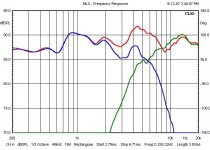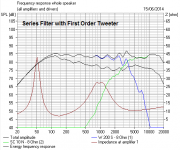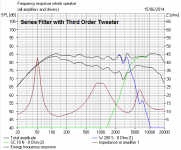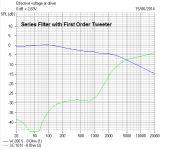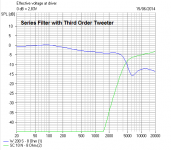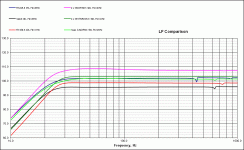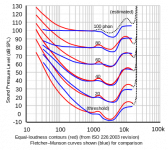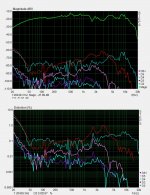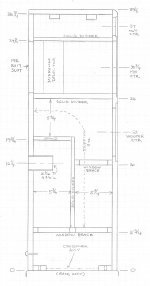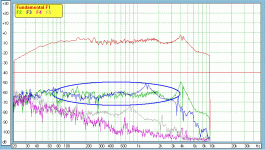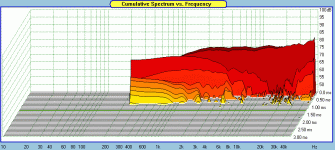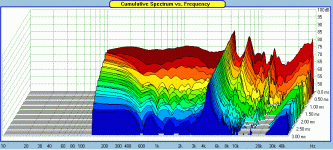I think we should get back on-topic with a look at what a simple filter does well, and what it does badly. This seems relevant to the Epos M12i.
Firstly, as Robin Marshall said, adding inductance to a polycone to lose the need for an input BSC coil is straightforward. I think he did a very nice job on that bass unit. A slightly difficult frequency response, but not an issue IMO. Off axis, things often look a lot better.
Where it gets more controversial is the use of a first order tweeter filter. This has a more even power delivery and phase and amplitude are not bad at all, especially off axis or with a degree of time alignment. So there is a lot to like. But whilst the tweeter frequency response looks OK, it hides the dreadful loss of power handling. The electrical response makes clear why the tweeter is struggling.
Some tweeters (like woofers) can handle low frequency excursion better than others, but this Epos is not a speaker that can go loud without distortion. A two way is a variously compromised design. You'll get more out of a three way. That's it really. 🙂
FWIW, I don't find the choice of a metal woofer over a paper woofer a no-brainer at all. There is a downside to metal drivers. But you can read of the strengths and weaknesses of paper and metal three ways below:
3-Way Classic
SEAS TJL3W
Firstly, as Robin Marshall said, adding inductance to a polycone to lose the need for an input BSC coil is straightforward. I think he did a very nice job on that bass unit. A slightly difficult frequency response, but not an issue IMO. Off axis, things often look a lot better.
Where it gets more controversial is the use of a first order tweeter filter. This has a more even power delivery and phase and amplitude are not bad at all, especially off axis or with a degree of time alignment. So there is a lot to like. But whilst the tweeter frequency response looks OK, it hides the dreadful loss of power handling. The electrical response makes clear why the tweeter is struggling.
Some tweeters (like woofers) can handle low frequency excursion better than others, but this Epos is not a speaker that can go loud without distortion. A two way is a variously compromised design. You'll get more out of a three way. That's it really. 🙂
FWIW, I don't find the choice of a metal woofer over a paper woofer a no-brainer at all. There is a downside to metal drivers. But you can read of the strengths and weaknesses of paper and metal three ways below:
3-Way Classic
SEAS TJL3W
Attachments
The single RS225 seems like a no brainer given the situation. 🙂
Very flat, goes the deepest and works in, what is comparatively, a small box. Also looks like it goes the loudest out of all the single driver systems and probably has the lowest distortion in the bass too.
Yes it does look good. I'll look at driver distortion next. Do you happen to have any measurements for the RS225. Zaph didn't do that one unfortunately.
I am not working to personal preferences I am working to a standard SPL level set by the recording industry to hear the intended tonal balance for a recording.
Sorry andy, that was my misinterpretation. Karl has expressed no need for the higher SPL levels (or standard levels I guess) so I am just trying to accommodate him.
Last edited:
I am afraid you ears and everyone else ears are non-linear with respect to sound level meaning there is only ever going to be one level where music will "come alive" and sound tonally as intended. You can choose to ignore it but those with an interest in hearing what was intended have little option but to listen at the assumed sound level. The fact that the commercial music industry has not defined a standard listening level says a great deal about the importance it gives to sound quality.I think the whole idea of arriving at an industry standard is bogus, regardless of whether it is precisely defined.
That is your choice but it is independent of what is required for the high fidelity reproduction of commercial music which is something I have choosen to be interested in.I don't listen to movies as loud as the specification would recommend and I listen to music at volume levels quite a bit lower than I watch movies at.
Steve you just made me realize that I forgot to include the Seas woofer. New chart is below. The Seas looks very similar to the Dayton RS225 but my box volume is fairly different that what Troels used, so I'm wondering how different the specs are from what Seas lists.
Fwiw, at this point my top 3 suggestions would be the following, although I am having a tough time with the ranking order:
1 - Amaroso
2 - Finalist
3a - Kairos (if SPL is satisfactory)
3b - SB 3-way with 2 x 17NRXC-8 (that Steve linked to, altho I am not familiar with these designers so I would want to double check the the implementation via simulation first)
Fwiw, at this point my top 3 suggestions would be the following, although I am having a tough time with the ranking order:
1 - Amaroso
2 - Finalist
3a - Kairos (if SPL is satisfactory)
3b - SB 3-way with 2 x 17NRXC-8 (that Steve linked to, altho I am not familiar with these designers so I would want to double check the the implementation via simulation first)
Attachments
I am afraid you ears and everyone else ears are non-linear with respect to sound level
Yes this is correct. You are referring to what are commonly called the Fletcher-Munsen curves.
....meaning there is only ever going to be one level where music will "come alive" and sound tonally as intended....
But this is a false conclusion to draw from them. In fact if you look at the curves below, there is really not that much of a difference in the shape of the curves (ie. in individual perception) between 80 and 100dB. Between 40 and 80db - yes, definitely. But regardless, this is diy. It's easy to tune the speaker so that the treble and bass get a little more emphasis if you only intend to listen at lower SPL levels. And perhaps this is where a 3-way has a little bit of an advantage over a 2-way for Karl. The adjustments can be done just by changing the resistors for the mid and/or the tweeter depending I guess on where the xo points are. Plus the LF tuning can also be altered to satisfy.
You can choose to ignore it but those with an interest in hearing what was intended have little option but to listen at the assumed sound level.
And this simply incorrect. You can use a receiver's loudness button or the bass and treble controls as well as the methods I just mentioned above.
Attachments
FWIW, I don't find the choice of a metal woofer over a paper woofer a no-brainer at all. There is a downside to metal drivers.
This comparison has nothing to do with the implementation, just how they perform for SPL vs bass extension. The RS225 looks like the best performer when it comes to required cabinet size, the extension it gives you and the SPL it can reach. It's also inexpensive.
We are assuming here that the designers have implemented the compared correctly.
Yes it does look good. I'll look at driver distortion next. Do you happen to have any measurements for the RS225. Zaph didn't do that one unfortunately.
As far as I remember this was done with 2.83V input in a small ~10L sealed box.
I am afraid you ears and everyone else ears are non-linear with respect to sound level meaning there is only ever going to be one level where music will "come alive" and sound tonally as intended. You can choose to ignore it but those with an interest in hearing what was intended have little option but to listen at the assumed sound level. The fact that the commercial music industry has not defined a standard listening level says a great deal about the importance it gives to sound quality.
Well whoop de do for my ears! I happen to enjoy listening to music at various different levels and it doesn't fail to 'come alive' at any of them. However I know I generally prefer to listen to music at an average level significantly below 85dB. More like an average of 75.
That is your choice but it is independent of what is required for the high fidelity reproduction of commercial music which is something I have choosen to be interested in.
This is absolute rubbish. Yes the ears frequency response might change a little as the level changes, but do bear in mind here that our brain is very adept at processing what the ears receive. One does not perceive a loss of detail if you turn the hifi down from 80 to 75dB, also one does not feel like all the bass has suddenly vanished and that the treble has gone up the swanny.
Music can be high fidelity at both higher and lower listening levels, what changes is the tonal balance that you perceive. Some people prefer a slightly brighter forward sound, some people prefer music with a more relaxed sound, there is no right or wrong when it comes to fine tuning how your system sounds.
One thing I do know is that if I turn it up too loud I get a headache and when that happens everything sounds bad.
Attachments
The Amaroso looks like quite an interesting design. I know those that have heard the Neo8 praise it very highly.
For the three ways I think it's a toss up between the Finalists and the Amaroso.
My only concern with the Amaroso is that its vertical off axis is going to be quite poor due to the height of the Neo8. Karl mentioned that he likes to slouch down into his sofa so this might have an impact on the sound. Ie it might shift somewhat in tonality as he sinks further into the chair.
The Finalists mount the midrange and the tweeter closer together and use a lower xover point, this will give a more even vertical off axis response, so would perhaps be more suitable.
One thing to mention is that the RS28 metal dome tweeter and the RS28F silk dome tweeter are pretty much interchangeable according to the folks that have designed with both over on the HT guide forums, so you've got the option to go with either if you have a preference for dome materials.
For the three ways I think it's a toss up between the Finalists and the Amaroso.
My only concern with the Amaroso is that its vertical off axis is going to be quite poor due to the height of the Neo8. Karl mentioned that he likes to slouch down into his sofa so this might have an impact on the sound. Ie it might shift somewhat in tonality as he sinks further into the chair.
The Finalists mount the midrange and the tweeter closer together and use a lower xover point, this will give a more even vertical off axis response, so would perhaps be more suitable.
One thing to mention is that the RS28 metal dome tweeter and the RS28F silk dome tweeter are pretty much interchangeable according to the folks that have designed with both over on the HT guide forums, so you've got the option to go with either if you have a preference for dome materials.
Wow. I'm feeling a bit overwhelmed with the level of response I'm getting here. It really puts into perspective for me just the level of thought and design that goes into a system.
I am keen to give the port tuning idea a go as you suggest. Interesting that you say it doesn't matter if the port sticks out the box - are there any commercial designs that have an adjustable port?
Karl,
My suggestion to you would be to try and audition some commercial designs. Don't worry too much about the price of the speakers you audition, worry more about the drivers (type, size and number) they have. This will give you an idea if a single 8" is enough or you need 2. While all woofers are NOT created equal, a single 8" can mean a large bookshelf/stand-mount, dual 8" would require floor standing.
You might find you prefer MMT to MTM or WWTM to WWMT or whatever. We all have our aural and visual preferences.
Domes, ring radiators, leaf/ribbon tweeters etc also have different characteristics. Knowing what you prefer will help you narrow choices and focus.
Similar with mids, doped paper cone, ceramic, metal all have different sound signatures. I settled on my combination of speakers (I built 2 pairs) after listening to the Excel drivers in Joesph Audio's Pearl and a Tidal ceramic system. Hence I built the Peridot-Excel (which uses Excel drivers for bass and mid) and Tempesta Extreme (which uses a ceramic mid). Could I afford the Pearl or Tidal, no way. But going DIY allowed me to afford something along the same lines.
Right now my new favourite for the mids is the Neo8. I first heard the Neo8 and Neo3 in a 3 way built by Karl Heinz Fink (using Vifa's PL woofers for the bass almost 15 years ago) but I did not find a reliable design that used this driver in a 3 way floor stander until this thread. What I liked about this driver was it's signature did not change much as I move from 1m to 3 m away.
Right now my new favourite for the mids is the Neo8. I first heard the Neo8 and Neo3 in a 3 way built by Karl Heinz Fink (using Vifa's PL woofers for the bass almost 15 years ago) but I did not find a reliable design that used this driver in a 3 way floor stander until this thread
you may see those
Giussani-Research | Delta 4 R8
But this is a false conclusion to draw from them. In fact if you look at the curves below, there is really not that much of a difference in the shape of the curves (ie. in individual perception) between 80 and 100dB. Between 40 and 80db - yes, definitely.
And this simply incorrect. You can use a receiver's loudness button or the bass and treble controls as well as the methods I just mentioned above.
So, to put words in your mouths, as you turn up the volume control you perceive a change in what we might call tonal balance but there isn't a level where your brain effectively switches from no that is too far away to be believable to yes that is close enough to accept.Well whoop de do for my ears! I happen to enjoy listening to music at various different levels and it doesn't fail to 'come alive' at any of them. However I know I generally prefer to listen to music at an average level significantly below 85dB. More like an average of 75.
This is absolute rubbish. Yes the ears frequency response might change a little as the level changes, but do bear in mind here that our brain is very adept at processing what the ears receive. One does not perceive a loss of detail if you turn the hifi down from 80 to 75dB, also one does not feel like all the bass has suddenly vanished and that the treble has gone up the swanny.
Music can be high fidelity at both higher and lower listening levels, what changes is the tonal balance that you perceive. Some people prefer a slightly brighter forward sound, some people prefer music with a more relaxed sound, there is no right or wrong when it comes to fine tuning how your system sounds.
One thing I do know is that if I turn it up too loud I get a headache and when that happens everything sounds bad.
Presumably if it is a case of preferences the idea of high fidelity is not a particularly useful one. It is a case of what sounds good to an individual like Youknowyou and his reference speakers.
Whatever, the good thing about standards even somewhat vague ones is that they are independent of all this sort of stuff. You can use them as part of the design objectives or not as one sees fit.
Interesting that you say it doesn't matter if the port sticks out the box - are there any commercial designs that have an adjustable port?
Not that I'm aware of. That of course doesn't mean there might not be though....
You can buy, or diy, sliding ports.
I fitted a port socket on the back of my speaker.
Unscrew the socket and swap to a different port length, screw back on.
I used twin 62mm drain pipe for a 9" bass driver.
I fitted a port socket on the back of my speaker.
Unscrew the socket and swap to a different port length, screw back on.
I used twin 62mm drain pipe for a 9" bass driver.
My only concern with the Amaroso is that its vertical off axis is going to be quite poor due to the height of the Neo8. Karl mentioned that he likes to slouch down into his sofa so this might have an impact on the sound. Ie it might shift somewhat in tonality as he sinks further into the chair.
Yes I understand that concern. I've eliminated the SB 3-way with the 6.5" mid partially because I estimated the tweeter height to be probably at least 40" and then the baffle is probably tilted upwards at about 8* to 10*. Not the best for a 32" listening height.
But with the Amarosos, the middle of the Neo8 sits at 30.75" so I think that should be fine. Maybe a little tilt downward for the tweeter axis though?
Thanks for the RS measurements btw.
Attachments
Presumably if it is a case of preferences the idea of high fidelity is not a particularly useful one. It is a case of what sounds good to an individual like Youknowyou and his reference speakers.
I would say more that an accurate loudspeaker is an accurate loudspeaker. Just because our ears are non linear, with respect to SPL, doesn't mean we need to compensate for this effect. This is something that is natural to us, things in every day life sound different at different volumes, but we don't tend to notice. It's like saying a movie is mixed for 85dB and you listen to it at 85dB, but if you turn it down or up by 10dB do the people speaking suddenly sound like different people? No of course not, they sound exactly the same!
Yes I understand that concern. I've eliminated the SB 3-way with the 6.5" mid partially because I estimated the tweeter height to be probably at least 40" and then the baffle is probably tilted upwards at about 8* to 10*. Not the best for a 32" listening height.
But with the Amarosos, the middle of the Neo8 sits at 30.75" so I think that should be fine. Maybe a little tilt downward for the tweeter axis though?
Thanks for the RS measurements btw.
Hmm, I was more concerned with the tonal balance shifting as the listening height changes, but if the listening height is always the same it doesn't matter as much.
I suppose with the Finalists it would be somewhat easier to tailor the height of the tweeter to match directly with the users ear height and if short stands are used one could change the stand height to match ear height if the listening conditions should change.
The Amarosos looks quite funky. Though a little goofy looking. I've always had a thing for ribbons. Though I have never heard one with an additional tweeter. I thought they were designed to extend into very high frequency?
On that note, I haven't seen the so called super tweeters cropping up in my googling of DIY designs. Are they a bit of a gimmick as opposed to a practical driver? I could never understand the reason for extending high frequency responce up to 50kHz when a) most equipment won't reproduce that and b) even if it could your hearing runs out waaaay before that. Unless you're a cat.
My sunken listening position now is really to compensate for uneven tone. If I don't slouch I add a good 8".
On that note, I haven't seen the so called super tweeters cropping up in my googling of DIY designs. Are they a bit of a gimmick as opposed to a practical driver? I could never understand the reason for extending high frequency responce up to 50kHz when a) most equipment won't reproduce that and b) even if it could your hearing runs out waaaay before that. Unless you're a cat.
My sunken listening position now is really to compensate for uneven tone. If I don't slouch I add a good 8".
I am not sure prolonging this is wise but... If things were to sound exactly the same why... No I am going to stop here.It's like saying a movie is mixed for 85dB and you listen to it at 85dB, but if you turn it down or up by 10dB do the people speaking suddenly sound like different people? No of course not, they sound exactly the same!
I am not sure prolonging this is wise but... If things were to sound exactly the same why... No I am going to stop here.
Obviously they don't sound exactly the same, the tonal balance changes still apply, the point I am getting at, is that even with these changes, our interpretation remains pretty much unchanged. Ella Fitzgerald still sounds as sublime at 65dB as she does at 75dB, as she does at 85dB. All that really happens when you turn things down too much is that the signal to noise ratio vanishes and certain details fall below the threshold of audibility. A similar thing could be said about turning it up too much, beyond a certain volume level the available detail, due to improve SnR wont increase, all that will happen is the loudspeakers show more signs of compression, distortion increases, your ears become less linear and the listening experience can generally become unpleasant. Not because of the increased distortion etc, but because you perceive it as being simply too loud.
As far as I am aware the guidelines for sound reproduction in home cinema isn't necessarily because of the ears tonal balance shift as volume changes. If this were the case then there would be ridiculously tight constraints on frequency response linearity, including off axis response, speaker diffraction control and room treatments. In other words, one set of THX spec speakers might sound positively lush and invite you to turn the volume up, whereas others might be a lot more forwards and make you want to turn things down before you've even got close to 85dB.
I thought the point of the specifications was so that you achieved the right balance across all the loudspeakers within the surround sound set up so that you achieve the correct level of immersion and so that the dynamic events within the movie have the desired effect. Such as the T-Rex stomping around in Jurassic Park. If you're listening at an average level of 65dB, instead of 85dB, your room isn't exactly going to shake and you're not going to be filled with the correct sense of foreboding.
This might seem to be going far off topic, but this is also relevant to music too, where if you're listening at low volume levels the impact of a crescendo, in a dynamic piece of classical music, will be completely lost. This isn't to say that the piece of music sounded flat and lifeless at a lower volume, more that quiet bangs don't scare us half as much as really loud bangs do. When you turn things down the sense of exhilaration is lost. Like the big fireworks going off at an event, some are designed to be visually very dismal, but instead be designed to go BOOM very loudly and to be felt in your chest. It gets the adrenalin going and has a very noticeable impact on your psyche. If the boom wasn't as loud the effect wouldn't be anywhere close to being the same. This is the same with music and with HT, where you simply need things at a certain volume for them to seem impressive or to have the emotional impact that they require. Turn it down and this aspect of it is lost and what the composer/writer/director intended fails to be successfully achieved. The same can be said of headphones too. You might have extension flat to 5Hz and the ability to hit 5Hz at some ridiculous SPL, but it seems dull and boring, why? Because with headphones you don't feel anything. An explosion in an action movie, that makes the room and my body shake, reproduced at the same SPL but on headphones? Yeah right, what's the point if I can't feel it.
I mean if you find listening at levels that enable that kind of thing to happen unpleasant then there's definitely no harm in you turning it down. For you maybe the impact of a crescendo occurs at a lower volume than for someone else. The musical beauty of a piece of music though, such as the harmonic composition or the ability of a piece of music to bring you to tears, isn't lost when you turn it down, quite the opposite in fact, you may notice it more because you're not being distracted by snap crackles and pops.
Karl, I think a combination of objective and subjective data is helpful in making decisions here so I wanted to try to introduce some harmonic distortion and cone resonance measurements into the discussion. Trouble is I'm not sure how helpful these are going to be for you and actually now that I've looked, I see that I can't find measurements for all the drivers under discussion so far. But I thought I'd give it a try anyways.
So first something in the way of very simple explanations.
In terms of harmonic distortion, less is better. To simplify, let's just look for the worst offender, the dissonant 3rd harmonic. In the 1st graph below, the red trace is the original FR and the blue line (circled) is the level of the 3rd order harmonic distortion. Pretty much just under the -60dB mark below the original which isn't too bad.
In terms of cone resonances, every cone tends to ring in some manner and for a certain period of time after the signal is stopped. Think of it like ringing a bell. Or perhaps like reverb. Obviously again, less is better. So with these CSD graphs, steep red cliffs (like the 2nd graph) are exceptional and colorful gradual hills or peaky ridges (3rd graph) are not so good - one is very crisp and clean while the other is smeared and out of focus. Notice where the time axis is in these graphs.
Now if that makes sense to you I'll continue. Otherwise subjective opinions will have to do.
So first something in the way of very simple explanations.
In terms of harmonic distortion, less is better. To simplify, let's just look for the worst offender, the dissonant 3rd harmonic. In the 1st graph below, the red trace is the original FR and the blue line (circled) is the level of the 3rd order harmonic distortion. Pretty much just under the -60dB mark below the original which isn't too bad.
In terms of cone resonances, every cone tends to ring in some manner and for a certain period of time after the signal is stopped. Think of it like ringing a bell. Or perhaps like reverb. Obviously again, less is better. So with these CSD graphs, steep red cliffs (like the 2nd graph) are exceptional and colorful gradual hills or peaky ridges (3rd graph) are not so good - one is very crisp and clean while the other is smeared and out of focus. Notice where the time axis is in these graphs.
Now if that makes sense to you I'll continue. Otherwise subjective opinions will have to do.
Attachments
The Amarosos looks quite funky. Though a little goofy looking. I've always had a thing for ribbons. Though I have never heard one with an additional tweeter. I thought they were designed to extend into very high frequency?
The B&G's aren't actually ribbons. They are planars. Similar but a different technology. They can reproduce much lower frequencies than a typical ribbon. And with much lower distortion. But from what I have read, they do share similar sound characteristics with ribbons. B&G actually make a number of different sized drivers for different applications. The Neo8 works best as a mid. They have a smaller one, the Neo3, that's meant as a tweeter.
They are quite low in distortion and membrane resonances so you end up getting that quick, clean and detailed sound of a ribbon extending down into the midrange as well. One of the other advantages of this driver is that there is no magnet behind the membrane like a typical cone driver, so the backwave has nothing in its way to cause reflections back out through the very thin foil membrane. So again, cleaner reproduction. And with the Amaroso, the designer has taken extra care to make sure that that backwave also doesn't get returned back to the driver because of cabinet reflections. That's a nice implementation.
But it's worth noting that with the Finalists, both the mid driver's magnet structure and its open back mid chamber are also trying to reduce backwave reflections as well. That's also a nice implementation.
Don't forget you can change some of the design features of the Amaroso to suit your own tastes - different side panels for eg. - but the rectangular Neo8 is what it is and the tuning of the bass chamber is much more specific than any of the other designs and probably shouldn't be changed without checking with Paul K, the designer. Maybe you can go with the angled and beveled front baffle edges too like the SB 3-way although I'm not completely sure about that.[/QUOTE]
On that note, I haven't seen the so called super tweeters cropping up in my googling of DIY designs. Are they a bit of a gimmick as opposed to a practical driver?
Yea, I don't think anybody is really using those in the diy community.
My sunken listening position now is really to compensate for uneven tone. If I don't slouch I add a good 8".
Good to know.
But with the Amarosos, the middle of the Neo8 sits at 30.75" so I think that should be fine. Maybe a little tilt downward for the tweeter axis though?
Given that the Neo 8 is an open back one mad idea came to me. How about making it spring loaded like the Humbucking pickups of a Les Paul. This will allow you to tilt the mid up or down a few degrees. I know it decouples the mid from the rear chamber but like I said it is just a mad idea.
Hmm, I was more concerned with the tonal balance shifting as the listening height changes, but if the listening height is always the same it doesn't matter as much.
MTMs have fewer tonal changes with respect to change in listening height but then their horizontal sweet spot is narrower too (and usually tighter).
The Amarosos looks quite funky. Though a little goofy looking.
On that note, I haven't seen the so called super tweeters cropping up in my googling of DIY designs. Are they a bit of a gimmick as opposed to a practical driver?
I think they look pretty smart. You can change the looks but changing the dressing though. Once more advantage of DIY.
If I remember right, the Neo 8 is hardly a true tweeter. It's preferred range is 1k-10k though it can be used lower. So yes it would require some HF help for the last octave or so.
They have a smaller one, the Neo3, that's meant as a tweeter.
there is no magnet behind the membrane like a typical cone driver, so the backwave has nothing in its way to cause reflections back out through the very thin foil membrane.
without checking with Paul K, the designer.
They also have a larger one called the Neo 10 and the ribbons (RD series) but when I heard all the Neos I like the Neo 8 best for the range it was in. I heard the Neo 8 and Neo 10 XOed to the Neo 3 and Vifa PL 22 woofers.
Oh so this is a Kettinger design. I thought it was yours, Jim. For those who do not know, Paul designed many of Philharmonic's loudspeakers as well as Salk's HT2-TL. Paul is a TL guru in the vein on Bud (Irvin) Fried.
- Status
- Not open for further replies.
- Home
- Loudspeakers
- Multi-Way
- Smashing my head against a wall...
